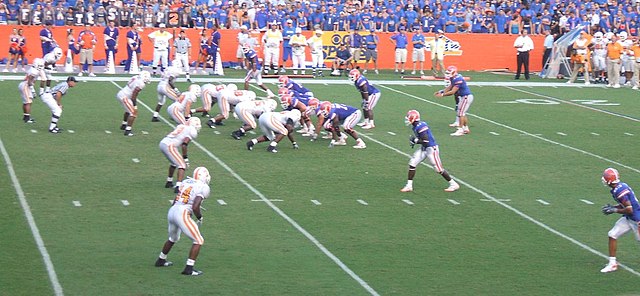The spread offense is an offensive scheme in gridiron football that typically places the quarterback in the shotgun formation, and "spreads" the defense horizontally using three-, four-, and even five-receiver sets. Used at every level of the game including professional, college, and high school programs across the US and Canada, spread offenses often employ a no-huddle approach. Some implementations of the spread also feature wide splits between the offensive linemen.
The Wake Forest Demon Deacons are lined up in a three-receiver spread package during a 2012 game against Boston College.
In the Houston Cougars' spread offense, Case Keenum became the NCAA's all-time leading passer.
The 2007 Florida Gators running Urban Meyer's spread option.
The New England Patriots lined up in a spread formation against the Philadelphia Eagles in 2007
The shotgun formation is a formation used by the offensive team in gridiron football mainly for passing plays, although some teams use it as their base formation. Instead of the quarterback receiving the snap from center at the line of scrimmage, in the shotgun he stands farther back, often five to seven yards off the line. Sometimes the quarterback will have a back on one or both sides before the snap, while other times he will be the lone player in the backfield with everyone spread out as receivers.
The Green Bay Packers (left) in the shotgun in a game against the New York Giants in 2007
The modern shotgun offense was developed by head coach Red Hickey of the San Francisco 49ers in 1960.
Tom Brady in the shotgun at Super Bowl XXXIX.
Side view of the shotgun formation








